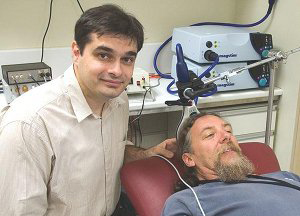
A headstart program? Corticomotor hyperexcitability testing may help clinicans diagnose ALS earlier and develop more effective treatments for the disease. Learn more by tuning into our Postcard from Sydney.
More than 20 potential treatments for ALS are being tested in the clinic. But for many people with ALS, the medicines developed may be too little too late. More than 70% of motor neurons by some estimates are lost in people with ALS one year after the first signs of muscle weakness – the time the disease often takes to be diagnosed.
A growing number of researchers are developing tools to identify people with ALS more quickly in hopes to more effectively treat their disease. One of these techniques, called threshold tracking transcranial magnetic stimulation (TMS), enables clinicians to measure increased levels of activity of key motor neurons in the brain and spinal cord. The changes, known as corticomotor hyperexcitability, may be an early step in ALS.
The test, developed by Neuroscience Research Australia’s Steve Vucic PhD and Matthew Kiernan MBBS, PhD, DSc, FRACP, may also help clinicians identify people that will likely develop familial ALS - months before the first signs of disease.
Brainstorming ALS
In 1992, Vancouver General Hospital’s Andrew Eisen MD proposed that the overactivity of motor neurons in the brain and spinal cord could lead to ALS by contributing to their destruction.
To put Eisen’s theory to the test, Neuroscience Research Australia’s Steve Vucic PhD and Matthew Kiernan MBBS, PhD, DSc, FRACP, turned to TMS. The technique enables researchers to measure the activity of key motor neurons by stimulating the motor cortex, the motion-enabling regions of the brain.
Fire when ready In TMS, a series of magnetic pulses is used to stimulate key circuits of the brain in order to evaluate them. The technique is currently being developed to diagnose and monitor a number of conditions including stroke. Video: Oliver Ende.
The researchers found that increased activity could be detected early in people with ALS – including C9ORF72, the most common form of the disease. What’s more, these changes according to a small study appeared months before the clinical onset of familial ALS – at least in SOD1-linked disease.
The results suggest that cortical hyperexcitability could be a general feature of ALS. And, these changes could be an early sign of disease.
Furthermore, TMS appears to distinguish ALS from other outwardly similar disorders – suggesting that this technique may help diagnose people with the disease. No significant increases in activity could be detected in people with key neuromuscular disorders often confused with ALS including multifocal motor neuropathy (MMN), spinal muscular atrophy (SMA) and Kennedy’s disease.
Now, the Neuroscience Research Australia team is working hard to bring TMS to the ALS clinic. The test could be in ALS clinics as early as next summer.
***
To learn more about emerging tools to diagnose ALS, read Imaging ALS. To find out about potential early treatments of ALS that may reduce hyperexcitability, check out Channeling ALS?